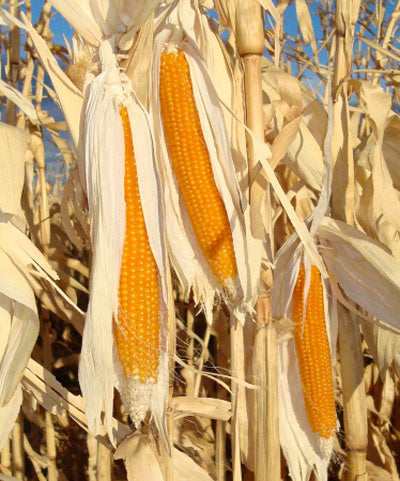Popcorn
Shop for Popcorn SeedsA more fun and playful take on the staple sweet corn, Popcorn is a great edible novelty that can be easily grown in any Utah garden with a little water, fertilizer, and love. It's growing season is slightly longer than the latest of the sweet corn varieties, but when harvested, dried, and prepared for popping, it's really a lot of fun to grow and eat your own delicious, colorful popcorn.
Soil Preparation
Corn prefers a sandy soil, rich in organic matter, well drained, and not too heavy. They also need full sun exposure. Before planting, incorporate 1-2 inches of well composted organic matter (poultry or other manures work great), Humic, and 4-6 pounds of high-nitrogen fertilizer (we recommend Ammonium Sulfate 21-0-0 or Milogranite for an organic alternative) per 1000 square feet and work them into a depth of 4-6 inches. Heavy, clay-based soils must be amended with compost and organic matter to encourage and allow for good root development. For best results, add 2-4 inches of a variety of different years to increase drainage and nutrient availability. By doing this yearly, over time you can create a better growing environment for your garden plants to thrive in and produce. Please consult our Soil Preparation Guide in the attached appendix.
Planting
Corn needs sun all day and will not tolerate shade very well. Once you have chosen your planting spot, mark out rows that are 3-4’ apart, and length doesn’t matter. For best pollination, it is recommended that you plant at least three rows. Locally, popcorn is planted anytime between Mother’s Day and mid June. There are two different methods for planting corn seed: a seeder or by hand. Depending on the type of seeder used, a seeder (Earthway Precision Seeder) will dig a shallow trench, drop individual seeds every 3-4 inches and then cover it up gently. The other method is to plant by hand, dropping 2 seeds every 12” about 1” deep. Once the seeds germinate, you can thin the plants as needed or let them all grow. We recommend no more than 3-4 plants every 12-18 inches. Without ample sunlight, corn will not produce full size ears, so make sure to space the corn correctly to enjoy a full harvest.
Varieties
We carry Robust White (white kernels), South American Yellow (yellow kernels), Blue Shaman (blue kernels), and Strawberry (red kernels). All the popcorn we carry will pop a fluffy, white kernel except the South American Yellow, which pops yellow (this is the most common type of popcorn, and also the least tasty of all our varieties). Fiesta Ornamental corn is a 4-5 inch long, multicolor decorative corn that will also pop.
Water
Make sure the seedlings do not dry out during the first few weeks of growth. Once plants are established, switch to a deep water method, either furrow watering a soaker or drip system. To encourage deep root development, let the plants stress slightly for water. This will help prevent your corn from laying over during high winds. We recommend deep watering once every 5-10 days depending on your soil type, with a total of 1-2” of water applied per week.
Fertilizer
Corn is a heavy feeder and needs nitrogen three times during the growing season. Sprinkle with a teaspoon of ammonium sulfate (20-0-0) around each hill when the plants are knee high (12”), hip high (36”), and when it starts to tassel. Make sure the fertilizer doesn’t make direct contact with the plants, and water thoroughly after application. If your corn doesn’t have enough nitrogen during development, your stalks will be short, the ears will be small (or undeveloped) and the kernels won’t fill out to the tips of the cobs. Fertilize, fertilize, fertilize! We also recommend treating your seed or plants with beneficial microbes and mycorrhizae (Kangaroots or Myke). These added helpers bring nutrients and water directly to the plants that host them, making them stronger, more resistant to insects and diseases, and more drought tolerant.
Common Problems
Corn regularly doesn’t experience too many problems during the growing season. The most common pest is the corn earworm. These fat green or brown worms hang out at the tip of the ear and do their damage to the top inch or two of the cob. Dusting the silks every 7-10 days with a permethrin based insecticide (we like Hi-Yield Garden, Pet and Livestock) or spraying with Ferti-lome Spinosad will help prevent this problem. It will also help prevent earwigs and grasshoppers from doing damage to your silks but will not interfere with pollination. Another problem you may run into is called corn smut. It is a fungus that infects the stalk and ears. We recommend removing any affected plants and discarding them. If you have had problems with smut in the past, plant your next crop in a different location and try a more resistant variety.


2 comments
Shauth Aafrika popcorn seeds
Aegrikalcar yus
I need to begin corn farming